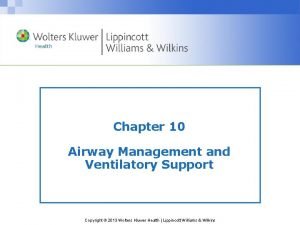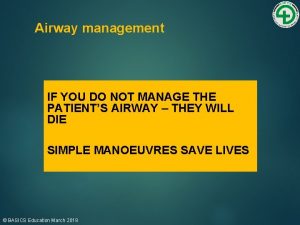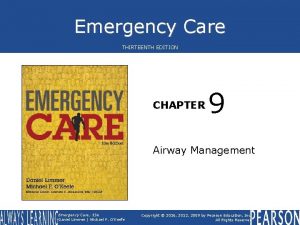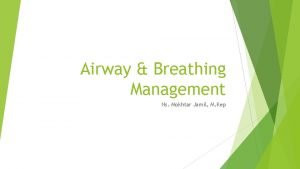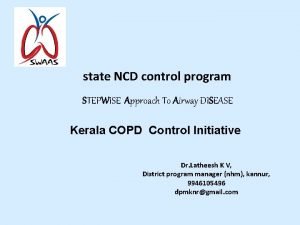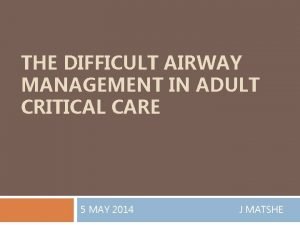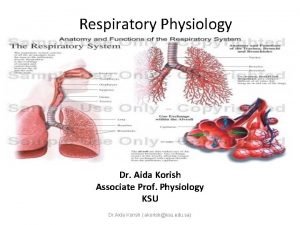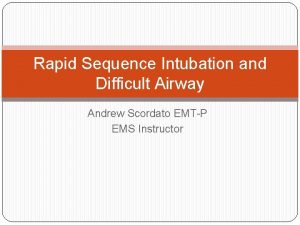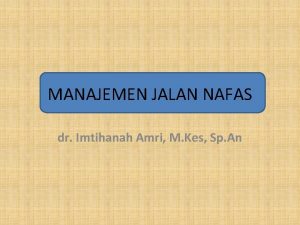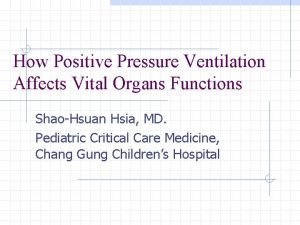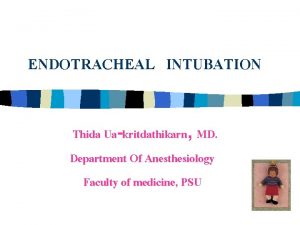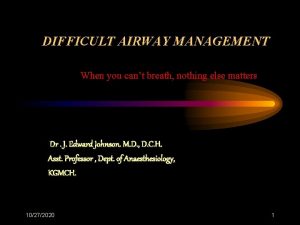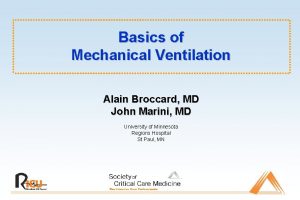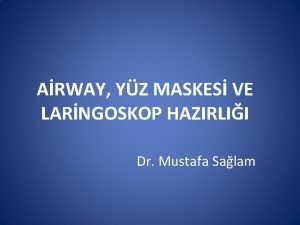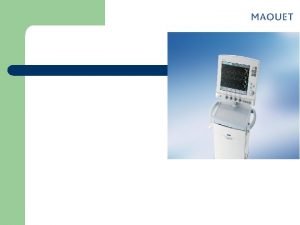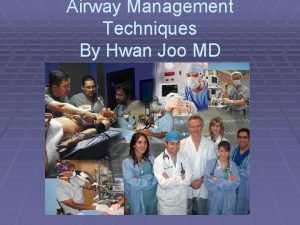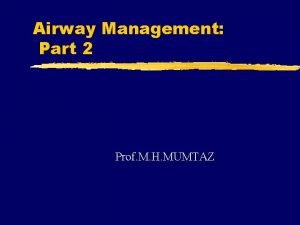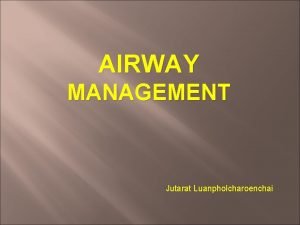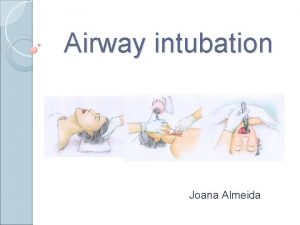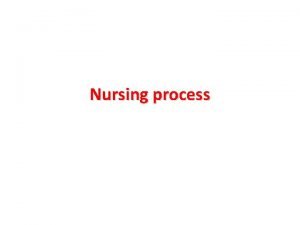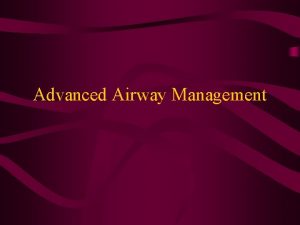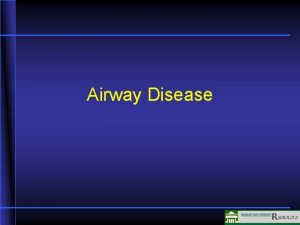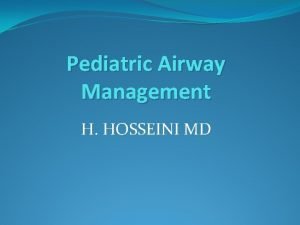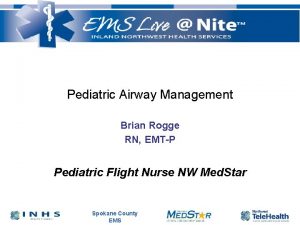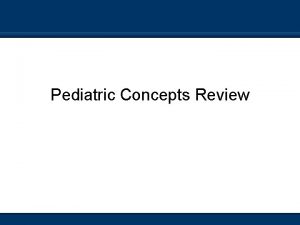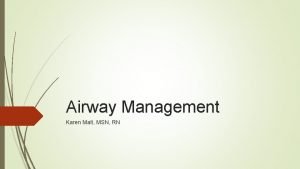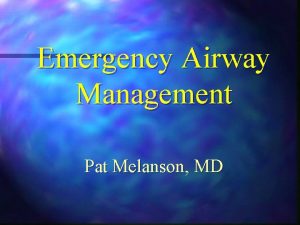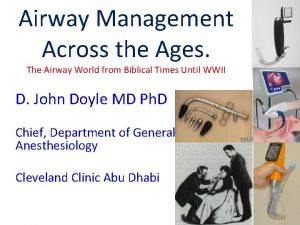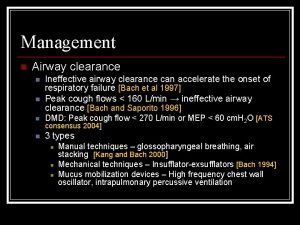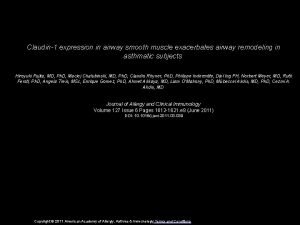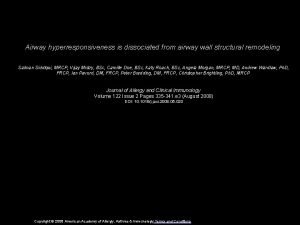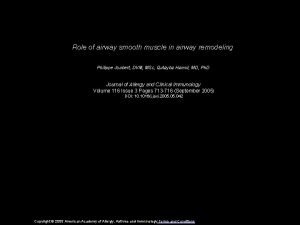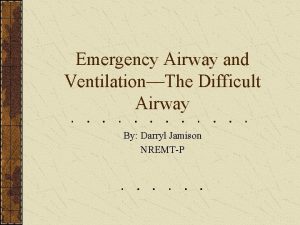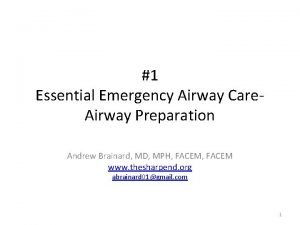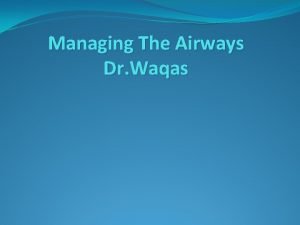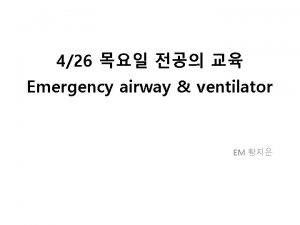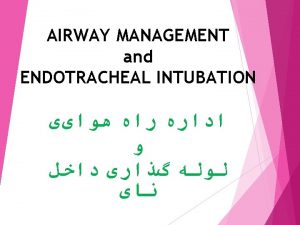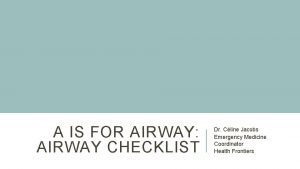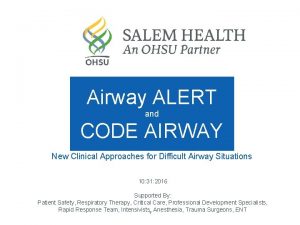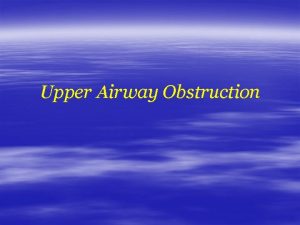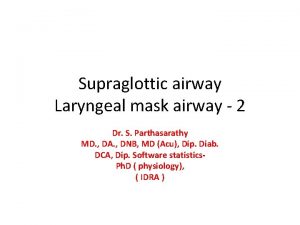Pediatric Airway Management for the NonAnesthesiologist David E
































- Slides: 32

Pediatric Airway Management for the Non-Anesthesiologist David E. Liston, MD, MPH Agnes Hunyady, MD Helen W. Karl, MD Updated: 2/2019 1

Objectives By the end of this workshop you will be able to: • Recognize and evaluate impending respiratory failure • Describe an airway evaluation • How to predict difficult face-mask ventilation (FMV) • How to predict difficult tracheal intubation • List effective FMV techniques • Explain laryngeal mask airway (LMA) placement • Describe tracheal intubation 2

Background (Pediatric airway management is changing) • Decreasing role of direct laryngoscopy (DL) • Reports document serious events after airway management failures 1 -4 • Effective face mask ventilation (FMV) is a critical initial step in airway management 5, 6 • New airway devices offer alternatives to direct laryngoscopy • Emphasis on a team approach to pediatric emergency airway management 6 • Leading cause of sentinel events: human factors 7 • Effective communication (i. e. Closed loop) • Team work (practice using simulation)8, 9 • Crew Resource Management: practice non-technical skills 10, 11 3

What do you see in a patient who has respiratory distress? • ↑ respiratory rate • ↑ respiratory effort • Nasal flaring • Retractions (use of accessory muscles - intercostal and subcostal) • ↓ respiratory effort • Abnormal airway sounds • ↑ heart rate • Stridor (usually inspiratory) • Wheezing (usually expiratory) • Grunting: glottic closure during expiration to maintain positive airway pressure • Changes in mental status Give supplemental O 2 and begin objective measurement (eg. oximetry) ASAP 4

What is a normal respiratory rate? 6 Age Category Age Range Normal Respiratory Rate (breaths per minute) Infant 0 – 12 months 30 – 53 Toddler 1 – 3 years 22 – 37 Preschooler 4 – 5 years 20 – 28 School Age 6 – 12 years 18 – 25 Adolescent 13 – 18 years 12 – 20 5

Respiratory Distress Initial Impression: ↑ work of breathing ↑ respiratory rate ↑ respiratory effort Will Progress To: irregular breathing ↓ respiratory effort Can Then Quickly Progress To: respiratory failure and ultimately. . . cardiac arrest! Keep treatment as simple as possible 12 6

Some causes of respiratory distress • Upper airway obstruction • Foreign body, anaphylaxis, secretions, edema, croup • Likely to have inspiratory stridor • Lower airway obstruction • Asthma, bronchiolitis, edema • Likely to have expiratory wheezing • Lung tissue disease • Eg. pneumonia, pulmonary edema, pneumothorax • Likely to have decreased or abnormal breath sounds • Abnormal respiratory control • Increased intracranial pressure (ICP) • Decreased level of consciousness (LOC) • Neuromuscular disease 7

What do you see in a patient with respiratory failure? • Marked tachypnea → bradypnea → apnea • Tachycardia → bradycardia • Poor breath sounds • Cyanosis • Stupor → coma Give supplemental O 2 and use objective measures (eg. oximetry) ASAP 8

Get ready to rescue • Understand check your equipment • Facemask ventilation (FMV) ** • Supraglottic ventilation [laryngeal mask airway (LMA)] • Direct laryngoscopy (DL) and tracheal intubation (TI) • Outline potential complications and how to avoid them • Equipment • Resources at your institution (Anesthesiology, ENT) • Patients: who is likely to present a particular challenge **THE most important skill 9

Prepare for Face Mask Ventilation (FMV) • Select appropriately sized transparent soft rimmed face mask • Understand how the equipment at your site of practice functions • Use supplemental oxygen • Make sure all equipment actually works: know how to test it! • Oxygen flow • Able to provide positive pressure 10

Equipment for Face Mask Ventilation (FMV) • Self-inflating bags • Age-appropriate sizes • Oxygen flow not required (to ventilate) • Blow-by O 2 delivered via corrugated tubing. • Provider skill level - basic • Flow-inflating bags • • • Age-appropriate sizes Oxygen flow required (to ventilate) Blow-by O 2 delivered via mask Provider skill level - advanced Can deliver very high pressure 11

The basics • Airway • • Support an open airway Clear secretions from nose and mouth Minimize agitation Consider oropharyngeal (OPA) or nasopharyngeal (NPA) airway • Be mindful of potential complications: gagging from OPA, pain and/or bleeding from NPA • Breathing • Provide supplemental oxygen and measure Sp. O 2 • Assist ventilation with positive pressure ventilation (PPV) • Administer medications to decrease airway edema FMV can be life-saving! 12

How do you evaluate the airway? History • Snoring, noisy breathing, sleep apnea • Cough, upper or lower respiratory infection • Previous anesthetic or airway problems • Neck injury • Syndromes Having a written plan for management of DA patients is key 13, 14 13

How do you evaluate the airway? 15 Physical examination • In general • • • Respiratory rate Increased work of breathing? Size of mouth, tongue and mandible Teeth Appearance: presence of anomalies? • Evaluation before anesthesia • • Mouth opening (Inter-incisor distance, IID) Modified Mallampati test (MMT) Thyromental distance (TMD) Upper lip bite test (ULBT)16 • Simultaneous assessment of jaw movement and protruding incisors 14

Modified Mallampati classification of Oropharyngeal view In children • Impossible in kids < 18 months and difficult below 5 years old • Poor predictive value, but still widely used 17 15

Optimize FMV 18 -20 • Create a tight seal between mask and face • E-C clamp technique • Lifts the jaw (sniffing position) • Keeps operator’s fingers off the soft tissues • Minimize gastric inflation • If child is breathing spontaneously, give PPV during inspiration • Use the lowest effective inspiratory pressure (keep <20 mm Hg) • Give breath over 1 second • Consider a 2 -person technique if difficult • Consider the lateral position 21 Practice! 16

Optimize FMV (Continued) • Watch the patient • Chest rise during inspiration • Condensation in the mask during exhalation • Have someone listen to the chest • Watch the available monitors • • Carbon dioxide (CO 2) curve on capnograph Color change on a colorimetric CO 2 detector Improvement in oxygen saturation (Sp. O 2) Prepare for escalation to LMA or ETT 17

6 essentials for Face Mask Ventilation 19 • Call for help • Reposition • Jaw thrust • Oropharyngeal airway (OPA) • May cause choking • Nasal pharyngeal airway (NPA) • AKA nasal trumpet • May cause bleeding • Two-person technique 18

Laryngeal mask airway (LMA) • Supraglottic Airway Device 22, 23 • Rescue device (per ASA difficult airway algorithm)15 • Can not intubate / can not ventilate scenario • Excellent given typical ease of placement • Early attempt at LMA placement if FMV not adequate • No paralytic, maintain spontaneous ventilation • Proper LMA size based on patient weight • LMA placement • Direct pressure backwards toward pharyngeal wall • Ensure depth of anesthesia to allow placement and prevent laryngospasm • Contraindications to LMA use • Patients with a higher risk of aspiration • Gastro-esophageal reflux (GERD) • Inadequate fasting times • Patients when controlled ventilation is critical 19

Pediatric airway management • Airway-related problems during general anesthesia • 4 x more common in children < 1 year old 20 • Infants have increased oxygen consumption and higher minute ventilation to FRC ratio • Develop hypoxemia much more quickly • Upper respiratory infections (URI) - common cause of laryngospasm and bronchospasm in kids • Wait 3 -4 weeks after a URI before general anesthesia 24 • Can be difficult given frequency of URIs in children 20

Difficult airway (DA) in children • Almost always associated with a syndrome with dysmorphic facial features, 25 especially bilateral microtia 26 • Obesity and a history of obstructive sleep apnea (OSA) are associated with difficult FMV 27 • Difficlut FMV is as high as 6%27 • Difficult intubation (DI) is more common in patients < 1 y and especially < 1 mo 28 • Unexpected DI is only 0. 045%25 • Can’t Ventilate-Can’t Intubate scenario is extremely rare 29 21

ASA Difficult Airway Algorithm Key Points • Assess the likelihood and clinical impact of basic management problems • Difficult ventilation • Difficult intubation • Difficulty with cooperation or consent • Difficult tracheostomy • Actively pursue opportunities to deliver supplemental O 2 during management • Call for help early • Preserve spontaneous ventilation 22

Direct Laryngoscopy (DL) and Tracheal Intubation (TI) • Establish indication • Checklist to gather equipment 30 • Suction, oxygen, ability to provide positive pressure ventilation are most important • Position patient (sniffing position) • Determine need for sedation/anesthesia 23

Sniffing Position (Optimize 1 st laryngoscopy attempt) T = axis of trachea P = axis of pharynx O = axis of oral Photo used with permission from Charles Coté 24

Direct Laryngoscopy • Open mouth • neck extension vs scissor fingers • Laryngoscopy blade • Insert from right side, sweep tongue to left • Pull handle up at a 45 degree angle, in a caudal direction • Do not bend wrist, may cause oral trauma 25

Direct Laryngoscopy • Expose larynx • Cormack-Lehane system for grading laryngoscopic view at intubation 31 • Optimize view • Adjust blade tip position in vallecula or on the epiglottis • External laryngeal manipulation (BURP maneuver) Grade 1 Grade 2 Grade 3 Grade 4 26

Tracheal Intubation • ETT selection • age/4 +3. 5 (4 if uncuffed) • Stylet • Depth • Height in cm/10 + 5 (4 if <4 months)32 • Cuff • <20 cm. H 2 O • Confirmation • Breath sounds, fogging, presence of Et. CO 2 • Call for help early • Do not continue to do the same thing & expect different result 27

References *Please note: any reference that is clickable has a link to the article free of charge 1. Cook TM, Woodall N, Frerk C. A national survey of the impact of NAP 4 on airway management practice in United Kingdom hospitals: closing the safety gap in anaesthesia, intensive care and the emergency department. Br J Anaesth. 2016; 117(2): 182 -90. 2. Cook TM, Woodall N, Harper J, Benger J, Fourth National Audit P. Major complications of airway management in the UK: results of the Fourth National Audit Project of the Royal College of Anaesthetists and the Difficult Airway Society. Part 2: intensive care and emergency departments. Br J Anaesth. 2011; 106(5): 632 -42. 3. Gausche M, Lewis RJ, Stratton SJ, Haynes BE, Gunter CS, Goodrich SM, et al. Effect of out-ofhospital pediatric endotracheal intubation on survival and neurological outcome: a controlled clinical trial. JAMA. 2000; 283(6): 783 -90. 4. Nishisaki A, Turner DA, Brown CA, 3 rd, Walls RM, Nadkarni VM, National Emergency Airway Registry for C, et al. A National Emergency Airway Registry for children: landscape of tracheal intubation in 15 PICUs. Crit Care Med. 2013; 41(3): 874 -85. Maconochie IK, de Caen AR, Aickin R, Atkins DL, Biarent D, Guerguerian AM, et al. Part 6: Pediatric Basic Life Support and Pediatric Advanced Life Support: 2015 International Consensus on Cardiopulmonary Resuscitation and Emergency Cardiovascular Care Science With Treatment Recommendations (Reprint). Pediatrics. 2015; 136 Suppl 2: S 88 -119. 6. American Heart Association. Pediatric Advanced Life Support - Provider Manual. 2016. 7. Joint Commission on Accreditation of Healthcare Organizations. Root causes of sentinel events (all categories, 1995 -2004) 2005. 8. Gaba DM, Howard SK, Fish KJ, Smith BE, Sowb YA. Simulation-Based Training in Anesthesia Crisis Resource Management (ACRM): A Decade of Experience. Simulation & Gaming. 2001; 32(2): 17593. 28

References 9. Dieckmann P, Friis SM, Lippert A, Østergaard D. Goals, Success Factors, and Barriers for Simulation. Based Learning: A Qualitative Interview Study in Health Care. Simulation & Gaming. 2012; 43(5): 627 -47. 10. Howard SK, Gaba DM, Fish KJ, Yang G, Sarnquist FH. Anesthesia crisis resource management training: teaching anesthesiologists to handle critical incidents. Aviat Space Environ Med. 1992; 63(9): 763 -70. 11. Clancy CM, Tornberg DN. Team. STEPPS: assuring optimal teamwork in clinical settings. Am J Med Qual. 2007; 22(3): 214 -7. 12. Greenland KB. Art of airway management: the concept of 'Ma' (Japanese: , when 'less is more'). Br J Anaesth. 2015; 115(6): 809 -12. 13. Black AE, Flynn PE, Smith HL, Thomas ML, Wilkinson KA, Association of Pediatric Anaesthetists of Great B, et al. Development of a guideline for the management of the unanticipated difficult airway in pediatric practice. Paediatr Anaesth. 2015; 25(4): 346 -62. 14. Weiss M, Engelhardt T. Proposal for the management of the unexpected difficult pediatric airway. Paediatr Anaesth. 2010; 20(5): 454 -64. 29

References 15. Apfelbaum JL, Hagberg CA, Caplan RA, Blitt CD, Connis RT, Nickinovich DG, et al. Practice Guidelines for Management of the Difficult Airway: An Updated Report by the American Society of Anesthesiologists Task Force on Management of the Difficult Airway. Anesthesiology. 2013; 118(2): 251 -70. 16. Khan ZH, Kashfi A, Ebrahimkhani E. A comparison of the upper lip bite test (a simple new technique) with modified Mallampati classification in predicting difficulty in endotracheal intubation: a prospective blinded study. Anesth Analg. 2003; 96(2): 595 -9. 17. Baudouin L, Bordes M, Merson L, Naud J, Semjen F, Cros AM. Do adult predictive tests predict difficult intubation in children? European Journal of Anesthesiology. 2006; 23: 63. 18. Davies JD, Costa BK, Asciutto AJ. Approaches to manual ventilation. Respir Care. 2014; 59(6): 810 -22; discussion 22 -4. 19. Eppich WJ, Zonfrillo MR, Nelson K, Hunt EA. Residents’ mental model of bag-mask ventilation. Pediatr Emerg Care. 2010; 26(9): 646 -52. 16. Holm-Knudsen RJ, Rasmussen LS. Paediatric airway management: basic aspects. Acta Anaesthesiol Scand. 2009; 53(1): 1 -9. 30

References 21. Arai YC, Kawanishi J, Sakakima Y, Ohmoto K, Ito A, Maruyama Y, et al. The lateral position improved airway patency in anesthetized patient with burn-induced cervico-mento-sternal scar contracture. Anesth Pain Med. 2016; 6(2): e 34953. 22. White MC, Cook TM, Stoddart PA. A critique of elective pediatric supraglottic airway devices. Paediatr Anaesth. 2009; 19 Suppl 1: 55 -65. 23. Ramesh S, Jayanthi R. Supraglottic airway devices in children. Indian Journal of Anaesthesia. 2011; 55(5): 476 -82. 24. Tait AR, Malviya S. Anesthesia for the child with an upper respiratory tract infection: still a dilemma? Anesth Analg. 2005; 100(1): 59 -65. 25. Heidegger T, Gerig HJ, Ulrich B, Kreienbuhl G. Validation of a simple algorithm for tracheal intubation: daily practice is the key to success in emergencies--an analysis of 13, 248 intubations. Anesth Analg. 2001; 92(2): 517 -22. 26. Uezono S, Holzman RS, Goto T, Nakata Y, Nagata S, Morita S. Prediction of difficult airway in school-aged patients with microtia. Paediatr Anaesth. 2001; 11(4): 409 -13. 27. Valois-Gomez T, Oofuvong M, Auer G, Coffin D, Loetwiriyakul W, Correa JA. Incidence of difficult bagmask ventilation in children: a prospective observational study. Paediatr Anaesth. 2013; 23(10): 920 -6. 31

References 28. Mirghassemi A, Soltani AE, Abtahi M. Evaluation of laryngoscopic views and related influencing factors in a pediatric population. Paediatr Anaesth. 2011; 21(6): 663 -7. 29. Sabato SC, Long E. An institutional approach to the management of the 'Can't Intubate, Can't Oxygenate' emergency in children. Paediatr Anaesth. 2016; 26(8): 784 -93. 30. Long E, Cincotta DR, Grindlay J, Sabato S, Fauteux-Lamarre E, Beckerman D, et al. A quality improvement initiative to increase the safety of pediatric emergency airway management. Paediatr Anaesth. 2017; 27(12): 1271 -7. 31. Krage R, van Rijn C, van Groeningen D, Loer SA, Schwarte LA, Schober P. Cormack-Lehane classification revisited. Br J Anaesth. 2010; 105(2): 220 -7. 32. Hunyady AI, Pieters B, Johnston TA, Jonmarker C. Front teeth-to-carina distance in children undergoing cardiac catheterization. Anesthesiology. 2008; 108(6): 1004 -8. 32
 Larangoscopy
Larangoscopy Tatalaksana acls
Tatalaksana acls Tracheostomy stoma
Tracheostomy stoma Airway ladder
Airway ladder Chapter 9 airway management
Chapter 9 airway management Technique abcde
Technique abcde Sandwich manuver
Sandwich manuver Stepwise airway management
Stepwise airway management Thyromental distance fingers
Thyromental distance fingers Pulmonary ventilation
Pulmonary ventilation External respiration
External respiration Respiratory airway secretary
Respiratory airway secretary Soap me intubation
Soap me intubation Intubation view grade
Intubation view grade Mallampati score
Mallampati score Servo pressure on jet ventilator
Servo pressure on jet ventilator Head tilt chin lift
Head tilt chin lift Mean airway pressure
Mean airway pressure Sellick manevrası
Sellick manevrası Mallampati score intubation
Mallampati score intubation Chandys maneuver
Chandys maneuver Occepital
Occepital Mean airway pressure formula
Mean airway pressure formula Ahi cpap
Ahi cpap Asp medical clinic
Asp medical clinic Airway numaraları
Airway numaraları Asa airway classification
Asa airway classification Aprv waveform
Aprv waveform Airway view
Airway view Ztechnique
Ztechnique Mallampati grad
Mallampati grad Sniffing position
Sniffing position Nursing process sequence
Nursing process sequence


